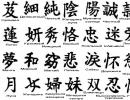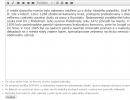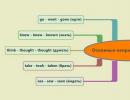Division of a circle into any number of equal parts. Mathematics lesson on the topic "Constructing a circle" (Grade 2) Construct a circumscribed circle using a compass
A circle is a closed curved line, each point of which is located at the same distance from one point O, called the center.

Straight lines connecting any point on a circle with its center are called radii R.
A line AB connecting two points of a circle and passing through its center O is called diameter D.
The parts of the circles are called arcs.
A line CD joining two points on a circle is called chord.
The straight line MN, which has only one common point with a circle is called tangent.
The part of a circle bounded by a chord CD and an arc is called segment.
The part of a circle bounded by two radii and an arc is called sector.
Two mutually perpendicular horizontal and vertical lines intersecting at the center of a circle are called circle axes.
The angle formed by two radii of KOA is called central corner.
Two mutually perpendicular radius make an angle of 90 0 and limit 1/4 of the circle.

We draw a circle with horizontal and vertical axes that divide it into 4 equal parts. Drawn with a compass or square at 45 0, two mutually perpendicular lines divide the circle into 8 equal parts.
Division of a circle into 3 and 6 equal parts (multiples of 3 by three)

To divide the circle into 3, 6 and a multiple of them, we draw a circle of a given radius and the corresponding axes. The division can be started from the point of intersection of the horizontal or vertical axis with the circle. The specified radius of the circle is successively postponed 6 times. Then the obtained points on the circle are successively connected by straight lines and form a regular inscribed hexagon. Connecting points through one gives an equilateral triangle, and dividing the circle into three equal parts.

The construction of a regular pentagon is performed as follows. We draw two mutually perpendicular axes of the circle equal to the diameter of the circle. Divide the right half of the horizontal diameter in half using the arc R1. From the obtained point "a" in the middle of this segment with radius R2, we draw an arc of a circle until it intersects with the horizontal diameter at point "b". Radius R3 from point "1" draw an arc of a circle to the intersection with a given circle (point 5) and get the side of a regular pentagon. The "b-O" distance gives the side of a regular decagon.
Dividing a circle into N-th number of identical parts (building a regular polygon with N sides)

It is performed as follows. We draw horizontal and vertical mutually perpendicular axes of the circle. From the top point "1" of the circle we draw a straight line at an arbitrary angle to the vertical axis. On it we set aside equal segments of arbitrary length, the number of which is equal to the number of parts into which we divide the given circle, for example 9. We connect the end of the last segment with the lower point of the vertical diameter. We draw lines parallel to the obtained one from the ends of the segments to the intersection with the vertical diameter, thus dividing the vertical diameter of the given circle into a given number of parts. With a radius equal to the diameter of the circle, from the lower point of the vertical axis we draw an arc MN until it intersects with the continuation of the horizontal axis of the circle. From points M and N we draw rays through even (or odd) division points of the vertical diameter until they intersect with the circle. The resulting segments of the circle will be the desired ones, because points 1, 2, …. 9 divide the circle into 9 (N) equal parts.
§ 1 Circle. Basic concepts
In mathematics, there are sentences that explain the meaning of a particular name or expression. Such sentences are called definitions.
Let's define the concept of a circle. A circle is a geometric figure consisting of all points of a plane located at a given distance from a given point.
This point, let's call it point O, is called the center of the circle.
The segment connecting the center with any point of the circle is called the radius of the circle. There are many such segments, for example, OA, OB, OS. They will all have the same length.
A line segment connecting two points on a circle is called a chord. MN is the chord of the circle.
The chord passing through the center of the circle is called the diameter. AB is the diameter of the circle. The diameter consists of two radii, which means that the length of the diameter is twice the radius. The center of a circle is the midpoint of any diameter.

Any two points on the circle divide it into two parts. These parts are called arcs of a circle.
ANB and AMB are circular arcs.
The part of the plane that is bounded by a circle is called a circle.
A compass is used to depict a circle in a drawing. The circle can also be drawn on the ground. To do this, just use the rope. Attach one end of the rope to a peg driven into the ground, and describe a circle with the other end.
§ 2 Constructions with a compass and a ruler
In geometry, many constructions can be performed using only a compass and a ruler without scale divisions.
Using only a ruler, you can draw an arbitrary line, as well as an arbitrary line passing through a given point, or a line passing through two given points.

The compass allows you to draw a circle of arbitrary radius, also a circle with a center at a given point and a radius equal to a given segment.
Separately, each of these tools makes it possible to make the simplest constructions, but with the help of these two tools, you can already perform more complex operations, for example,
solve building problems such as
Construct an angle equal to a given one,
Construct a triangle with given sides,
Divide the segment in half
Through a given point, draw a line perpendicular to the given line, and so on.
Let's consider the problem.
Task: On a given ray from its beginning, set aside a segment equal to the given one.

Given a ray OS and a segment AB. It is necessary to construct a segment OD, equal to the segment AB.
Using a compass, we construct a circle of radius equal to the length of the segment AB, centered at point O. This circle will intersect the given ray OS at some point D. The segment OD is the desired segment.
List of used literature:
- Geometry. Grades 7-9: textbook. for general education organizations / L.S. Atanasyan, V.F. Butuzov, S.B. Kadomtsev and others - M .: Education, 2013. - 383 p.: ill.
- Gavrilova N.F. Pourochnye development in geometry Grade 7. - M.: "WAKO", 2004. - 288s. - (To help the school teacher).
- Belitskaya O.V. Geometry. 7th grade. Part 1. Tests. - Saratov: Lyceum, 2014. - 64 p.
This lesson is devoted to the study of the circle and the circle. Also, the teacher will teach you to distinguish between closed and open lines. You will get acquainted with the basic properties of a circle: center, radius and diameter. Learn their definitions. Learn to determine the radius if the diameter is known, and vice versa.
If you fill in the space inside the circle, for example, draw a circle with a compass on paper or cardboard and cut it out, then we get a circle (Fig. 10).
Rice. 10. Circle
Circle is the part of a plane bounded by a circle.
Condition: Vitya Verkhoglyadkin drew 11 diameters in his circle (Fig. 11). And when he counted the radii, he got 21. Did he count correctly?

Rice. 11. Illustration for the problem
Solution: radii should be twice as many as diameters, so:
Vitya counted incorrectly.
Bibliography
- Mathematics. Grade 3 Proc. for general education institutions with adj. to an electron. carrier. At 2 h. Part 1 / [M.I. Moro, M.A. Bantova, G.V. Beltyukova and others] - 2nd ed. - M.: Education, 2012. - 112 p.: ill. - (School of Russia).
- Rudnitskaya V.N., Yudacheva T.V. Mathematics, 3rd grade. - M.: VENTANA-GRAF.
- Peterson L.G. Mathematics, 3rd grade. - M.: Juventa.
- Mypresentation.ru ().
- Sernam.ru ().
- School-assistant.ru ().
Homework
1. Mathematics. Grade 3 Proc. for general education institutions with adj. to an electron. carrier. At 2 h. Part 1 / [M.I. Moro, M.A. Bantova, G.V. Beltyukova and others] - 2nd ed. - M.: Enlightenment, 2012., Art. 94 No. 1, art. 95 no. 3.
2. Solve the riddle.
We live together with my brother,
We have so much fun together
We will put a mug on the sheet (Fig. 12),
Let's circle it with a pencil.
Get what you need -
It's called...

3. It is necessary to determine the diameter of the circle if it is known that the radius is 5 m.
4. * Using a compass, draw two circles with radii: a) 2 cm and 5 cm; b) 10 mm and 15 mm.
A sentence that explains the meaning of a particular expression or name is called definition. We have already met with definitions, for example, with the definition of an angle, adjacent angles, isosceles triangle etc. Let us define another geometric figure- circles.
Definition
This point is called circle center, and the segment connecting the center with any point of the circle is circle radius(Fig. 77). From the definition of a circle it follows that all radii have the same length.
Rice. 77
A line segment connecting two points on a circle is called its chord. The chord passing through the center of the circle is called its diameter.
In figure 78, the segments AB and EF are the chords of the circle, the segment CD is the diameter of the circle. Obviously, the diameter of a circle is twice its radius. The center of a circle is the midpoint of any diameter.

Rice. 78
Any two points on a circle divide it into two parts. Each of these parts is called an arc of a circle. In Figure 79, ALB and AMB are arcs bounded by points A and B.

Rice. 79
To depict a circle in a drawing, use compass(Fig. 80).

Rice. 80
To draw a circle on the ground, you can use a rope (Fig. 81).

Rice. 81
The part of the plane bounded by a circle is called a circle (Fig. 82).

Rice. 82
Constructions with a compass and a ruler
We have already dealt with geometric constructions: draw straight lines, set aside segments equal to the data, draw angles, triangles and other figures. At the same time, we used a scale ruler, a compass, a protractor, a drawing square.
It turns out that many constructions can be done using only a compass and straightedge without scale divisions. Therefore, in geometry, those tasks for construction are specially distinguished, which are solved using only these two tools.
What can be done with them? It is clear that the ruler allows one to draw an arbitrary line, as well as to construct a line passing through two given points. Using a compass, you can draw a circle of arbitrary radius, as well as a circle with a center at a given point and a radius equal to a given segment. By performing these simple operations, we can solve many interesting building problems:
construct an angle equal to a given one;
through a given point draw a line perpendicular to the given line;
divide this segment in half and other tasks.
Let's start with a simple task.
Task
On a given ray from its beginning, set aside a segment equal to the given one.
Solution
Let's depict the figures given in the condition of the problem: the ray OS and the segment AB (Fig. 83, a). Then, with a compass, we construct a circle of radius AB with center O (Fig. 83, b). This circle will intersect the ray OS at some point D. The segment OD is the required one.

Rice. 83
Examples of building tasks
Constructing an angle equal to a given one
Task
Set aside from the given ray an angle equal to the given one.
Solution
This angle with vertex A and the ray OM are shown in Figure 84. It is required to build an angle, equal to the angle And, so that one of its sides coincides with the beam OM.

Rice. 84
Let's draw a circle of arbitrary radius with the center at the vertex A of the given angle. This circle intersects the sides of the corner at points B and C (Fig. 85, a). Then we draw a circle of the same radius with the center at the beginning of the given ray OM. It intersects the beam at point D (Fig. 85, b). After that, we construct a circle with center D, the radius of which is equal to BC. Circles with centers O and D intersect at two points. Let us denote one of these points by the letter E. Let us prove that the angle MOE is the required one.

Rice. 85
Consider triangles ABC and ODE. The segments AB and AC are the radii of a circle with center A, and the segments OD and OE are the radii of a circle with center O (see Fig. 85, b). Since by construction these circles have equal radii, then AB = OD, AC = OE. Also, by construction, BC = DE.
Therefore, Δ ABC = Δ ODE on three sides. Therefore, ∠DOE = ∠BAC, i.e. the constructed angle MOE is equal to the given angle A.
The same construction can be performed on the ground, if instead of a compass we use a rope.
Constructing an angle bisector
Task
Construct the bisector of the given angle.
Solution
This angle BAC is shown in Figure 86. Let's draw a circle of arbitrary radius with a center at vertex A. It will intersect the sides of the angle at points B and C.

Rice. 86
Then we draw two circles of the same radius BC with centers at points B and C (only parts of these circles are shown in the figure). They intersect at two points, at least one of which lies inside the corner. We denote it by the letter E. Let us prove that the ray AE is the bisector of the given angle BAC.
Consider triangles ACE and ABE. They are equal on three sides. Indeed, AE is the common side; AC and AB are equal as radii of the same circle; CE = BE by construction.
From the equality of triangles ACE and ABE it follows that ∠CAE = ∠BAE, i.e. the ray AE is the bisector of the given angle BAC.
Comment
Can a given angle be divided into two equal angles using a compass and straightedge? It is clear that it is possible - for this you need to draw a bisector of this angle.
This angle can also be divided into four equal angles. To do this, you need to divide it in half, and then divide each half in half again.
Is it possible to divide a given angle into three equal angles using a compass and straightedge? This task, called angle trisection problems, has attracted the attention of mathematicians for many centuries. It was only in the 19th century that it was proved that such a construction is impossible for an arbitrary angle.
Construction of perpendicular lines
Task
Given a line and a point on it. Construct a line passing through a given point and perpendicular to a given line.
Solution
The given line a and the given point M belonging to this line are shown in Figure 87.

Rice. 87
On the rays of the straight line a, emanating from the point M, we set aside equal segments MA and MB. Then we construct two circles with centers A and B of radius AB. They intersect at two points: P and Q.
Let us draw a line through the point M and one of these points, for example, the line MP (see Fig. 87), and prove that this line is the desired one, that is, that it is perpendicular to the given line a.
Indeed, since the median PM of an isosceles triangle PAB is also the altitude, then PM ⊥ a.
Construction of the middle of the segment
Task
Construct the midpoint of this segment.
Solution
Let AB be the given segment. We construct two circles with centers A and B of radius AB. They intersect at points P and Q. Draw a line PQ. The point O of the intersection of this line with the segment AB is the desired midpoint of the segment AB.
Indeed, triangles APQ and BPQ are equal in three sides, so ∠1 = ∠2 (Fig. 89).

Rice. 89
Consequently, the segment RO is the bisector of the isosceles triangle ARV, and hence the median, that is, the point O is the midpoint of the segment AB.
Tasks
143. Which of the segments shown in Figure 90 are: a) chords of a circle; b) the diameters of the circle; c) the radii of a circle?

Rice. 90
144. Segments AB and CD are diameters of a circle. Prove that: a) chords BD and AC are equal; b) chords AD and BC are equal; c) ∠BAD = ∠BCD.
145. Segment MK is the diameter of a circle with center O, and MR and RK are equal chords of this circle. Find ∠POM.
146. The segments AB and CD are the diameters of a circle with center O. Find the perimeter of the triangle AOD, if it is known that CB = 13 cm, AB = 16 cm.
147. Points A and B are marked on a circle with center O so that the angle AOB is a right one. Segment BC is the diameter of the circle. Prove that chords AB and AC are equal.
148. Two points A and B are given on a straight line. On the continuation of the beam BA, set aside the segment BC so that BC \u003d 2AB.
149. Given a line a, a point B not lying on it, and a segment PQ. Construct a point M on the line a so that BM = PQ. Does the problem always have a solution?
150. Given a circle, a point A not lying on it, and a segment PQ. Construct a point M on the circle so that AM = PQ. Does the problem always have a solution?
151. Danes sharp corner YOU and beam XY. Construct the angle YXZ so that ∠YXZ = 2∠BAC.
152. Obtuse angle AOB is given. Construct the ray OX so that the angles XOA and XOB are equal obtuse angles.
153. Given a line a and a point M not lying on it. Construct a line passing through point M and perpendicular to line a.
Solution
Let's construct a circle with a center at a given point M, intersecting a given straight line a at two points, which we denote by the letters A and B (Fig. 91). Then we construct two circles with centers A and B passing through the point M. These circles intersect at the point M and at one more point, which we denote by the letter N. Let's draw the line MN and prove that this line is the desired one, i.e. it is perpendicular to straight line a.

Rice. 91
Indeed, triangles AMN and BMN are equal in three sides, so ∠1 = ∠2. It follows that the segment MC (C is the point of intersection of the lines a and MN) is the bisector of the isosceles triangle AMB, and hence the height. Thus, MN ⊥ AB, i.e., MN ⊥ a.
154. Dan triangle ABC. Construct: a) the bisector AK; b) VM median; c) the height CH of the triangle. 155. Using a compass and ruler, construct an angle equal to: a) 45°; b) 22°30".
Answers to tasks
152. Instruction. First, construct the bisector of angle AOB.
In construction problems, a compass and a ruler are considered ideal tools, in particular, a ruler has no divisions and has only one side of infinite length, and a compass can have an arbitrarily large or arbitrarily small opening.
Permissible constructions. The following operations are allowed in construction tasks:
1. Mark a point:
- arbitrary point of the plane;
- an arbitrary point on a given line;
- an arbitrary point on a given circle;
- the point of intersection of two given lines;
- points of intersection/tangency of a given straight line and a given circle;
- points of intersection/tangency of two given circles.
2. Using a ruler, you can build a straight line:
- arbitrary straight line on the plane;
- an arbitrary line passing through a given point;
- a straight line passing through two given points.
3. Using a compass, you can build a circle:
- arbitrary circle on the plane;
- arbitrary circle centered at given point;
- an arbitrary circle with a radius equal to the distance between two given points;
- a circle centered at a given point and with a radius equal to the distance between two given points.
Solving building problems. The solution of the construction problem contains three essential parts:
- Description of the method of constructing the desired object.
- Proof that the object constructed in the described way is really the desired one.
- Analysis of the described construction method for its applicability to different variants of initial conditions, as well as for the uniqueness or non-uniqueness of the solution obtained by the described method.
Construction of a segment equal to a given one. Let there be given a ray with origin at the point $O$ and a segment $AB$. To construct a segment $OP = AB$ on a ray, one needs to construct a circle centered at the point $O$ of radius $AB$. The intersection point of the ray with the circle will be the desired point $P$.
Constructing an angle equal to a given one. Let there be given a ray with the origin at the point $O$ and an angle $ABC$. With the center at the point $B$ we construct a circle with an arbitrary radius $r$. Denote the points of intersection of the circle with the rays $BA$ and $BC$ $A"$ and $C"$ respectively.

Let's construct a circle centered at the point $O$ of radius $r$. Denote the intersection point of the circle with the ray by $P$. Let's construct a circle centered at the point $P$ of radius $A"B"$. Denote the intersection point of the circles by $Q$. Let's draw a ray $OQ$.


We get the angle $POQ$ equal to the angle $ABC$, since the triangles $POQ$ and $ABC$ are equal on three sides.
Construction of a perpendicular bisector to a segment. We construct two intersecting circles of arbitrary radius with centers at the ends of the segment. Connecting the two points of their intersection, we get the perpendicular bisector.
Construction of the bisector of an angle. Let's draw a circle of arbitrary radius with the center at the corner vertex. Let's construct two intersecting circles of arbitrary radius with centers at the points of intersection of the first circle with the sides of the angle. By connecting the vertex of the angle to any of the intersection points of these two circles, we obtain the bisector of the angle.
Construction of the sum of two segments. To construct a segment on a given ray equal to the sum of two given segments, it is necessary to apply the method of constructing a segment equal to a given one twice.


Construction of the sum of two angles. In order to postpone from a given ray an angle equal to the sum of two given angles, it is necessary to apply the method of constructing an angle equal to a given one twice.
Finding the midpoint of a segment. In order to mark the middle of a given segment, you need to build a perpendicular bisector to the segment and mark the point of intersection of the perpendicular with the segment itself.
Construction of a perpendicular line through a given point. Let it be required to construct a line perpendicular to the given one and passing through the given point. We draw a circle of arbitrary radius with a center at a given point (regardless of whether it lies on a straight line or not), intersecting a straight line at two points. We build a perpendicular bisector to the segment with ends at the points of intersection of the circle with the line. This will be the desired perpendicular line.
Constructing a parallel line through a given point. Let it be required to construct a line parallel to a given one and passing through a given point outside the line. We construct a line passing through a given point and perpendicular to a given line. Then we build a straight line passing through this point, perpendicular to the constructed perpendicular. The straight line thus obtained will be the required one.






